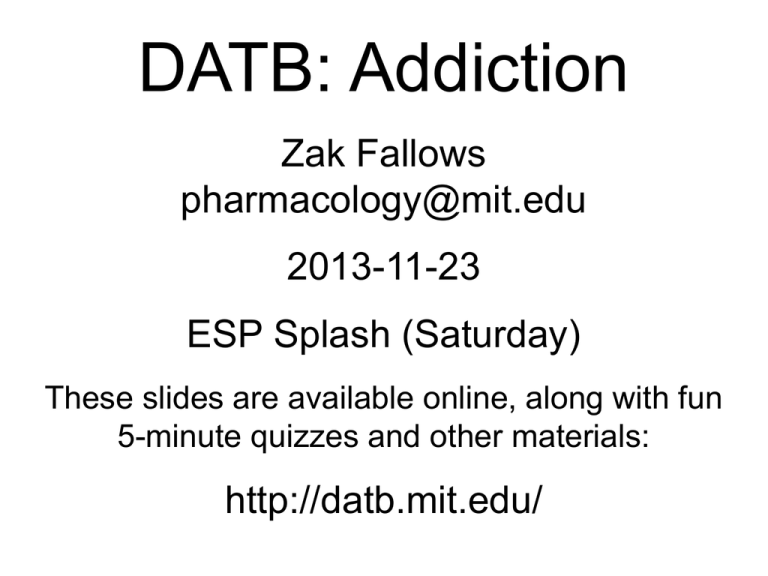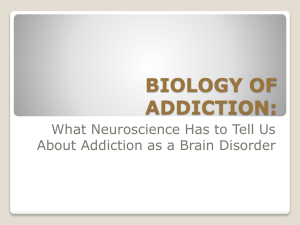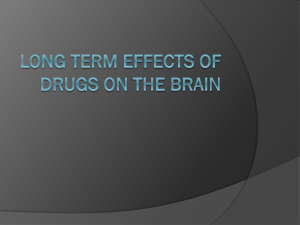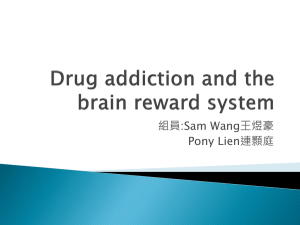
DATB: Addiction
Zak Fallows
pharmacology@mit.edu
2013-11-23
ESP Splash (Saturday)
These slides are available online, along with fun
5-minute quizzes and other materials:
http://datb.mit.edu/
Please Reuse These Slides
I hereby release these slides under the
Creative Common – Attribution license
(CC-BY license). You may freely reuse
these slides, just please give credit to me
as the original author.
© 2013, CC-BY, by Zak Fallows
What Is Addiction?
Addiction is continued use of a
substance despite harms that
outweigh the benefits, with a lack
of control over substance use.
Types of Harm
Physical: Infection, injury, brain damage
Psychological: Anxiety, depression, guilt,
shame
Social: Prison, loss of employment,
disowned by friends and family
Monetary: Bankruptcy, forced to work in
prostitution or drug dealing
Evidence of Lack of Control
Broken promises to oneself: “I will only
have two beers tonight.”
Broken promises to others: “I will not be
late to work again.”
Feeling helpless: “I could not possibly go
a week without cocaine.”
Evidence of Lack of Control
Lying, including lying to doctors, to family,
or to oneself.
Lying about substance use, about level of
control, about level of harm, or about level
of benefit from the substance.
Signal (bursts per second)
Dopamine signals unexpected rewards
Eats peanut
Time (seconds)
Dopamine signals predicted/expected rewards
First trial:
“Good
monkey”
Eats peanut
Tenth trial:
“Good
monkey”
Eats peanut
Time (seconds)
Dopamine signals error in prediction
Tenth trial:
“Good
monkey”
Eats peanut
“Good
monkey”
No peanut
No peanut:
Time (seconds)
The dopamine burst motivates the animal
Signal (bursts per second)
The dopamine motivates the
child, focuses the child’s
attention on the goal, and
facilitates the behavior (truck
chasing) that will lead to
reward.
Ice cream
truck music
Chases truck
Eats ice cream
Drugs of abuse mimic natural reward
First dose:
Sees
cocaine
Snorts cocaine
Sees
cocaine
Snorts cocaine
Fiftieth dose:
Time (seconds)
Why does seeing cocaine cause dopamine release?
Remember how conditioning normally works:
First trial:
“Good
monkey”
Eats peanut
Tenth trial:
“Good
monkey”
Eats peanut
Time (seconds)
Drugs of abuse mimic natural reward
When an addict sees cocaine, the
dopamine burst produced by his
own cells motivates him to get
cocaine and snort it.
The pleasure an addict actually
feels from snorting cocaine is
decreased over time, due to
tolerance
Fiftieth dose:
Sees
cocaine
Snorts cocaine
Time (seconds)
Drug addicts are insensitive to non-drug motivators
The incentive of freedom triggers a
dopamine burst, which motivates the
person to wash the car
Normal
person:
“Wash my car
or go to prison”
The addict has tolerance to both
cocaine and their own dopamine, so
they cannot be motivated by normal
incentives
Addict:
What will the
addict do?
“Stay clean or
go to prison”
Sees cocaine
Time (seconds)
Liking versus wanting
Addicts don’t like doing drugs as much as they
used to
Addicts want to do drugs
Addicts don’t want to do anything else
Speed of onset and addiction
Drugs which take effect quickly are more
addictive, because a fast spike in dopamine
more closely mimics natural rewards and the
drug-taking behavior is more closely
associated with the reward if they come close
together
Speed of onset and addiction
Faster onset, more
addictive:
Crack cocaine
Injected heroin
Smoked meth (ice)
Slower onset, less
addictive:
Powder cocaine (snorted,
has an 11 minute
absorption half-time)
Snorted heroin (absorbed
faster than snorted
cocaine. Why?)
Snorted meth (even less
addictive: swallowed
meth)
Speed of onset and addiction
Faster onset, more
Slower onset, less
addictive:
addictive:
Xanax (the fast elimination Klonopin, Librium
and need for more
doses also increases
addiction potential.
Why do frequent doses
lead to stronger
addiction? Discuss.)
Speed of onset and addiction
Faster onset, more
addictive:
Snorted Ritalin
Vicodin
Abused (chewed, crushed
and snorted) OxyContin
Slower onset, less
addictive:
Oral Ritalin
OxyContin
Properly used (intact timerelease tablets)
OxyContin
ADHD
ADHD is treated with stimulants that boost dopamine
(and norepinephrine), why does this work?
Dopamine normally facilitates goal-directed behavior
by:
•Increasing motivation
•Focusing attention on the goal
•Providing energy to work towards the goal
•Speeding learning and reinforcing memory
ADHD
Why does dopamine speed learning and reinforce
memory?
Discuss
Common Confusion
The following factors are not part of the
definition of addiction:
Tolerance
Withdrawal
Dependence
Tolerance
Drug tolerance is the need for
increasingly large doses to reach the
same effect.
Many non-addictive drugs cause
tolerance, for example diphenhydramine
(Benadryl).
Tolerance
Addiction can exist without tolerance. In
fact, many addictive drugs cause the
opposite of tolerance, which is called
sensitization.
Classical stimulants are most noted for
causing sensitization, including cocaine
and methamphetamine.
Tolerance
Tolerance does not increase forever,
there is a ceiling.
Opioids such as heroin and morphine
probably display the most dramatic
tolerance. In opioid addicts, 50-fold
tolerance is sometimes observed. In sick
people with extreme pain, opioid
tolerance can grow even higher.
Tolerance
Tolerance to stimulants is much more limited
and harder to gauge. Stimulant addicts may
display 5- to 10-fold tolerance.
Stimulant users may display 2-fold
sensitization, meaning that the drug is twice
as potent as it was when they first used it.
They only need a half dose. More commonly,
they take a full dose and get twice as high.
Tolerance is not
part of addiction
Withdrawal
Withdrawal is the name for unpleasant
symptoms that arise when you reduce the
dose or discontinue drug use.
Many non-addictive drugs cause
withdrawal, including glucocorticoid
steroids such as dexamethasone and
blood pressure medications. In fact,
dexamethasone withdrawal can be fatal.
Withdrawal
Drug addiction can exist without
withdrawal. Crack cocaine addicts almost
universally can abstain from drug use for
a whole day without bothersome
withdrawal.
Withdrawal is not
part of addiction
Dependence
Dependence means that you would
experience withdrawal if you tried to stop.
Thus, dependence is almost a synonym
for withdrawal, and as such it is
orthogonal to addiction.
Unfortunately, many people use the word
dependence as a synonym for addiction,
which is just awful in my opinion.
Dependence is not
part of addiction
What Is Addiction?
Addiction is continued use of a
substance despite harms that
outweigh the benefits, with a lack
of control over substance use.
Addiction Can Be Hard to Diagnose
The following factors can make it hard to
diagnose addiction:
Lying
Uncertain harms from the substance
Uncertain benefits from the substance
Preexisting problems, which are not
due to the substance
However, addiction is often
very easy to diagnose.
Most of the people who use heroin
or cocaine every day are clearly
and unquestionably addicts.
Despite all this uncertainty about
diagnosis, it is important to keep two
things in mind:
First, full-blown addicts cannot plausibly
remain in denial or fool their doctors and
family.
Second, borderline addicts or nearaddicts should be careful. They are
walking a fine line, and they need to be
watched, guided, and cautioned.
Slide Title
Lorem ipsum sit amet dolori placum
nocebus tensori. Alegri metamonum et
fidelim.
More space-filling text here, this time in
English. Yes, this is dummy text for
typesetting purposes.
A third paragraph of junk.








